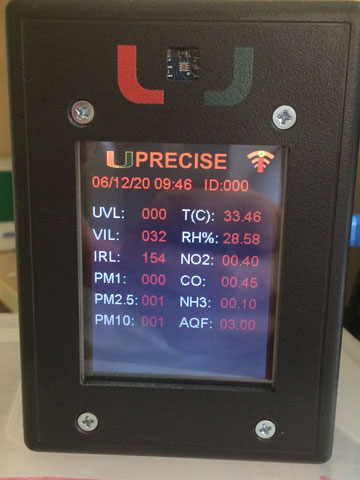By Robert C. Jones Jr.
7-14-2020
Daily commutes to and from the office grounded to a halt. Restaurants closed their dining rooms, operating as takeout establishments, only. Gyms, barbershops, and nail salons shuttered. And people, except for trips to the grocery store or pharmacy, pretty much stayed at home.
When the nation’s governors imposed shelter-in-place orders in their states earlier this year in hopes of reining in surging cases of COVID-19, Naresh Kumar, a University of Miami public health scientist who studies the environmental burden of disease, knew that the special sensors he had placed in more than 30 residential homes in Miami and the city of Baltimore would eventually have a story to tell.
Now, as most states have started to lift restrictions and reopen their economies, those sensors are telling that story. During a two-month period from April through May, when residents spent the majority of their time indoors complying with COVID-19 lockdown orders, levels of harmful substances in those homes increased dramatically, degrading the quality of indoor air.
And shutdown directives imposed to curtail the coronavirus were the cause of those spikes, said Kumar, an associate professor of environmental health at the Miller School of Medicine.

While his findings are still preliminary, the numbers he has downloaded from his environmental sensors are nonetheless startling. Amounts of fine particulate pollution, which is also known as PM2.5 because the particles are less than 2.5 micrometers in diameter, rose by 30 percent over that two-month span. Meanwhile, concentrations of ammonia, carbon monoxide, and nitrogen dioxide climbed by 2.7 percent, 15 percent, and 4 percent, respectively. “But it’s what people did inside their residences during stay-at-home orders that contributed to those increases,” Kumar said.
With restaurants offering only takeout, more people cooked meals at home, some using gas-powered ranges that produced carbon monoxide and which didn’t have effective exhaust hoods.
And as concerns over the spread of COVID-19 grew, people took disinfecting to a new level, often overusing harsh cleaning products and exposing themselves to dangerous compounds like ammonium chloride, Kumar noted. From January to March, poison control centers reported a 20 percent increase in calls compared to the same period last year, according to the Centers for Disease Control Prevention, which used data from the National Poison Data System.
While National Ambient Air Quality Standards imposed by the EPA have helped mitigate outdoor air pollution, indoor air quality—which is unregulated—remains largely poor. This results in toxic conditions that may lead to such illnesses as cardiopulmonary disease, asthma, C.O.P.D., and other respiratory ailments.
“Outdoor air quality in the United States has largely gotten better over the past four to five decades,” Kumar said. “People in impoverished countries now breathe the same poor quality of outdoor air that we used to breathe in the 1960s and ’70s.
“But there’s a public health paradox, in that along with the declines in outdoor air pollution we’ve experienced, we should have seen corresponding drops in the disease burden of certain ailments like asthma, allergies, and dry eye,” Kumar continued. “But we’re not seeing those declines. They’re actually getting worse. And part of the reason, I believe, is largely because people are spending most of their time indoors, where the air quality is bad.”
As part of Kumar’s ongoing research on indoor environmental conditions, the 33 sensors he has placed in residential homes—15 in Miami and 18 in Baltimore—continue to track levels of particulate matter and other substances in real time. A long-range study examining whether those harmful substances led to respiratory illnesses remains a possibility, he said.
But at least one investigation has already found a link between indoor air quality and a specific ailment. In a study recently published online in the Journal of the American Medical Association, Kumar and others established a connection between the indoor environment—specifically, humidity and air pollutants—and symptoms of dry eye.
Funded in part by the National Eye Institute, the study sampled 97 subjects from the Miami VA Hospital, monitoring indoor environmental conditions in their homes within seven days of a clinical visit and ultimately finding that levels of indoor particulate matter were associated with dry eye metrics.
Studies examining the effect of indoor air quality on health are rare, even though sources of indoor air pollution run the gamut—from building materials and furniture made of pressed wood to deteriorating asbestos in insulation, flooring, upholstery, and carpet. Household cleaning and personal-care products also are a contributing factor, Kumar said. As such, more such studies are needed, he pointed out.
Kumar recommended the following measures to help reduce indoor air pollutants.
- Ensure that gas stoves are well ventilated.
- Use carbon monoxide detectors.
- Use a dehumidifier to reduce moisture.
- Buy certain indoor plants that are proven to help absorb harmful toxins in the air—such as formaldehyde and carbon monoxide.
- Don’t smoke indoors, or better yet, quit altogether.
- Dust surfaces.
- Avoid using strong disinfectants with chlorine, which is highly reactive and can irritate the eyes, nose, and throat.
- If using disinfectants with chlorine, open doors and windows to ventilate.








